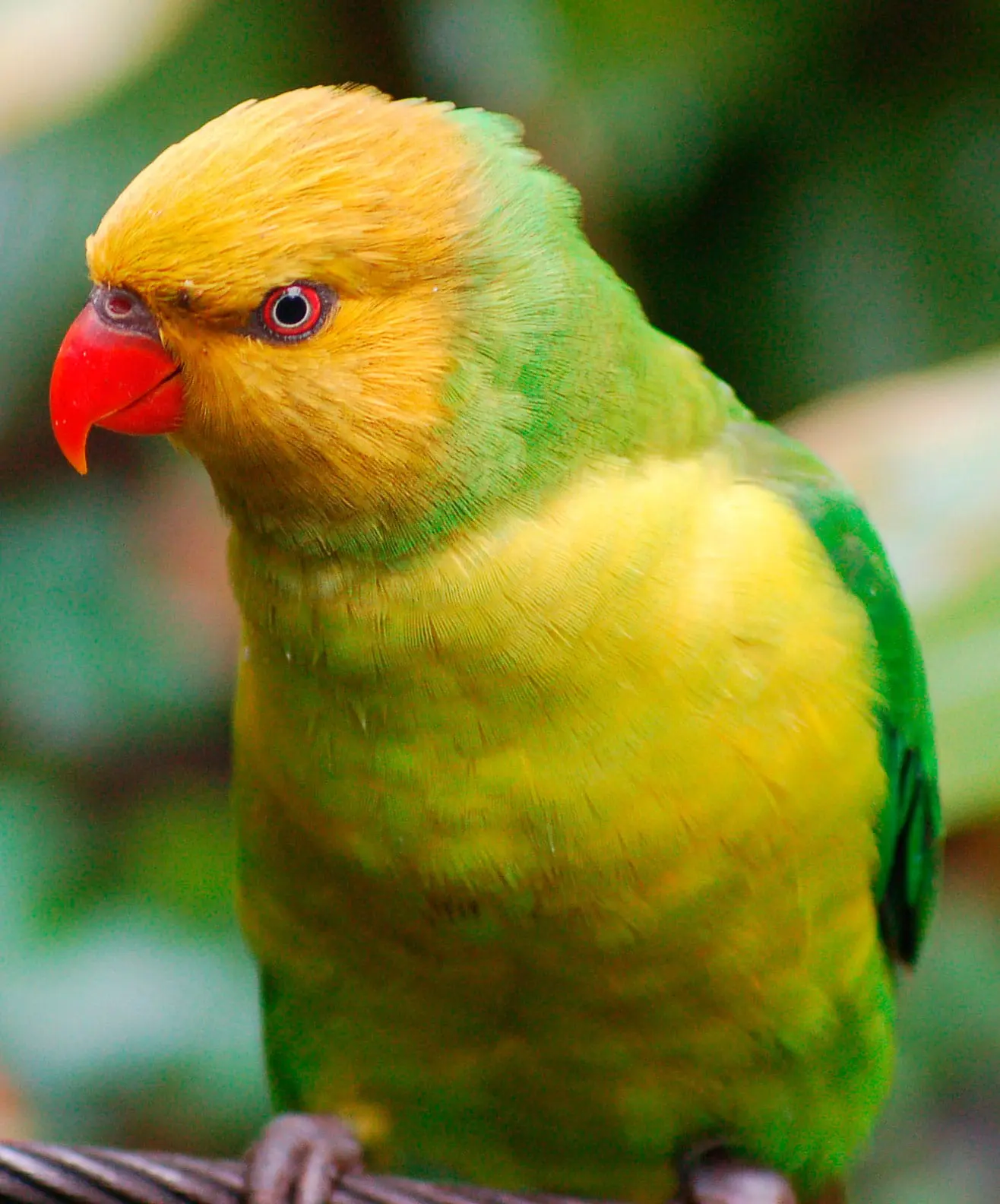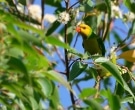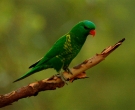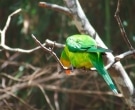Its length is about 25 cm. and weigh between 80 and 85 gr.
The Olive headed Lorikeet (Trichoglossus euteles) show, in general, a green shade.
The head color is olive with waves pale mustard and yellow stripes over the entire surface of the top.
The neck and its part rear are surrounded by a collar of color green brilliant that continues until the throat.
The underparts below the throat are entirely greenish-yellow.
The bill is red-orange. The irises they are red, and legs grey.
The youth they are more muted than adults. Its head is slightly greenish with streaks pale. The bill is brown. The irises They are brown. The species is considered monotype.
- Sound of the Olive headed Lorikeet.
Habitat:
They frequent humid subtropical forests., secondary forests and wooded meadows. Adapt quite well to cultivated land and the gardens in cities.
In Timor, they are relatively abundant between 1.000 and 2.300 meters above sea level, apparently, substitute to the Coconut Lorikeet in these heights. Also they can be observed at sea level in the island of Timor. In the rest of the Islands it frequents lowland areas.
The Olive headed Lorikeet they live in small groups. They are especially visible when they are in flight because they emit continuously shouts. On the other hand, when feeding or resting in trees, they are very difficult to observe because of their green plumage mixed with the color of the foliage.
They are birds territorial, capable of showing great aggressiveness if the limits of their area of influence are violated.
Usually disperse in search of their food, forming large groups when resources are abundant.
Outside the breeding season they form large roaming flocks of a hundred or more individuals.. Move in flying fast and slightly wavy.
In Timor, during the season, dry, These birds seem to descend below 1.000 meters and are scattered in coastal areas.
Reproduction:
The anidacio seasonn would take place perhaps between September and October, but this information needs to be confirmed.
In captivity, the Olive headed Lorikeet put 3 white eggs that parents are in charge of incubate for a few 23 days. As in the majority of the Lori, the nesting cycle is particularly long.
Food:
Feed primarily of nectar and fruit. They forage in trees in flower and shrubs.
Distribution:
Size of the area of distribution (reproduction / resident): 38.100 km2
Timor and Lesser Sunda Islands, from the East of Lembata until Nila and Babar.
Conservation:
• Current IUCN Red List category: Least concern
• Population trend: Stable
The population size This species has not been quantified. Suspected that the population is stable in the absence of evidence of any reduction or substantial threats.
Like most brightly plumaged parrots, the Olive headed Lorikeet It victim of trade bird cage or Aviary.
"Olive headed Lorikeet" in captivity:
Pretty common. They can be housed with others of its kind.
Alternative names:
– Olive headed Lorikeet, Olive-headed Lorikeet, Perfect Lorikeet (ingles).
– Loriquet eutèle (French).
– Gelbkopflori (German).
– Lóris-de-cabeça-amarilla (Portuguese).
– Lori Humilde, Tricogloso Humilde (español).
scientific classification:
– Order: Psittaciformes
– Family: Psittaculidae
– Genus: Trichoglossus
– Scientific name: Trichoglossus euteles
– Citation: (Temminck, 1835)
– Protonimo: Psittacus euteles
Images “Olive headed Lorikeet”:
Videos "Olive headed Lorikeet"
———————————————————————————————–
“Olive headed Lorikeet” (Trichoglossus euteles)
Sources:
– Avibase
– Parrots of the World – Joseph Forshaw M
– Parrots-A Guide to the Parrots of the World by Tony Juniper & Mike Parr
– BirdLife.org
– Photos:
1 – Photo by and (C)2007 Derek Ramsey (Ram-Man) – Self-photographed – Wikipedia
2 – By James Eaton – IBC.lynxeds.com
3 – “Trichoglossus euteles-captive-8a-ec” by Trichoglossus_euteles_-captive-8a.jpg: Ruth Rogersderivative work: Snowmanradio (talk) – originally posted to Flickr as P8120395 and uploaded to commons at Trichoglossus_euteles_-captive-8a.jpg. Licensed under CC BY 2.0 via Wikimedia Commons.
4 – "Scaly-breasted Lorikeet Kobble Dec06" von Aviceda – Eigenes Werk. Lizenziert unter CC BY-SA 3.0 über Wikimedia Commons.
5 – By Marcella (Picasa Web Albums) [CC-BY-SA-3.0], via Wikimedia Commons
– Sounds: Colin Trainor (Xeno-canto)






